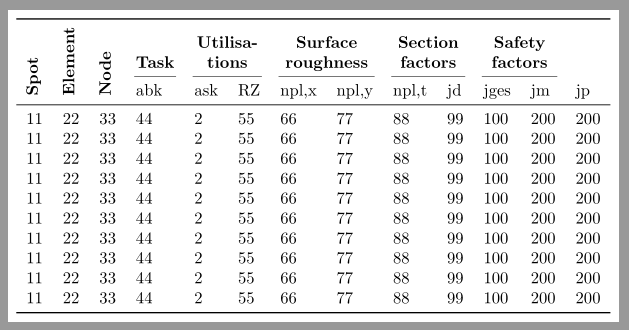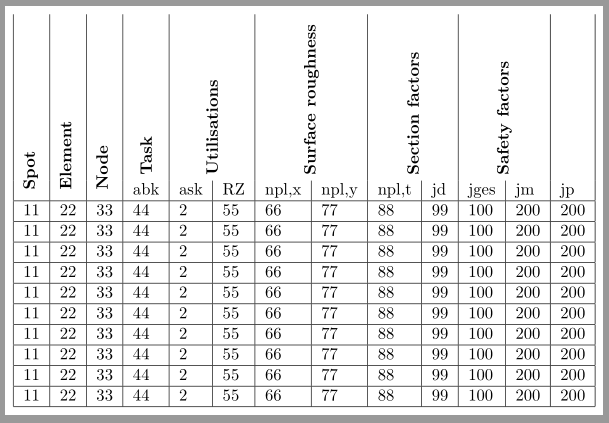|
Wie kann ich den Text in einer Tabelle um 90 Grad drehen sodass er in einer Zelle Senkrecht steht? bzw. wie kann ich dann die Zellenhöhe dem Text anpassen? Danke \documentclass[preview,border=0pt]{standalone} \usepackage{tikz} \usepackage{multicol} \usepackage{multirow} \usepackage{longtable} \begin{document} \begin{tabular}{|*{91}{l|}} \multirow{2}{3cm}{\textbf{Spot}} & \multirow{2}{3cm}{\textbf{Element}} & \multirow{2}{3cm}{\textbf{Node}} & \multirow{2}{3cm}{\textbf{Task}} & \multicolumn{2}{c|}{\textbf{Utilisations}} & \multicolumn{2}{c|}{\textbf{Surface roughness}} & \multicolumn{2}{c|}{\textbf{Section factors}} & \multicolumn{2}{c|}{\textbf{Safety factors}} \\ & & & abk & ask & RZ & npl,x & npl,y & npl,t & jd & jges & jm & jp \\ \hline 11 & 22 & 33 & 44 & 2& 55 & 66 & 77 & 88 & 99 & 100 & 200 & 200 \\ \hline 11 & 22 & 33 & 44 & 2& 55 & 66 & 77 & 88 & 99 & 100 & 200 & 200 \\ \hline 11 & 22 & 33 & 44 & 2& 55 & 66 & 77 & 88 & 99 & 100 & 200 & 200 \\ \hline 11 & 22 & 33 & 44 & 2& 55 & 66 & 77 & 88 & 99 & 100 & 200 & 200\\ \hline 11 & 22 & 33 & 44 & 2& 55 & 66 & 77 & 88 & 99 & 100 & 200 & 200 \\ \hline 11 & 22 & 33 & 44 & 2& 55 & 66 & 77 & 88 & 99 & 100 & 200 & 200 \\ \hline 11 & 22 & 33 & 44 & 2& 55 & 66 & 77 & 88 & 99 & 100 & 200 & 200 \\ \hline 11 & 22 & 33 & 44 & 2& 55 & 66 & 77 & 88 & 99 & 100 & 200 & 200 \\ \hline 11 & 22 & 33 & 44 & 2& 55 & 66 & 77 & 88 & 99 & 100 & 200 & 200 \\ \hline 11 & 22 & 33 & 44 & 2& 55 & 66 & 77 & 88 & 99 & 100 & 200 & 200 \\ \hline \end{tabular} \end{document}
|
|
Dafür bietet sich das Paket \documentclass[preview,border=5pt]{standalone} \usepackage{booktabs} \usepackage{rotating} \newcommand\tabrotate[1]{\begin{turn}{90}\rlap{#1}\end{turn}} \usepackage{varwidth} \newcommand\tabvarwidth[2][3cm]{\begin{varwidth}[b]{#1}\centering #2\end{varwidth}} \begin{document} \begin{tabular}{*{13}{l}} \toprule\addlinespace[1em] &&& \multicolumn{1}{c}{\textbf{Task}}& \multicolumn{2}{c}{\tabvarwidth{\bfseries Utilisa-\\tions}}& \multicolumn{2}{c}{\tabvarwidth{\bfseries Surface\\ roughness}}& \multicolumn{2}{c}{\tabvarwidth{\bfseries Section\\ factors}}& \multicolumn{2}{c}{\tabvarwidth{\bfseries Safety\\ factors}} &\\ \cmidrule(rl){4-4}\cmidrule(rl){5-6}\cmidrule(rl){7-8}\cmidrule(rl){9-10}\cmidrule(rl){11-12} \tabrotate{\bfseries Spot}& \tabrotate{\bfseries Element}& \tabrotate{\bfseries Node}& abk & ask & RZ & npl,x & npl,y & npl,t & jd & jges & jm & jp \\ \midrule 11 & 22 & 33 & 44 & 2& 55 & 66 & 77 & 88 & 99 & 100 & 200 & 200\\ 11 & 22 & 33 & 44 & 2& 55 & 66 & 77 & 88 & 99 & 100 & 200 & 200\\ 11 & 22 & 33 & 44 & 2& 55 & 66 & 77 & 88 & 99 & 100 & 200 & 200\\ 11 & 22 & 33 & 44 & 2& 55 & 66 & 77 & 88 & 99 & 100 & 200 & 200\\ 11 & 22 & 33 & 44 & 2& 55 & 66 & 77 & 88 & 99 & 100 & 200 & 200\\ 11 & 22 & 33 & 44 & 2& 55 & 66 & 77 & 88 & 99 & 100 & 200 & 200\\ 11 & 22 & 33 & 44 & 2& 55 & 66 & 77 & 88 & 99 & 100 & 200 & 200\\ 11 & 22 & 33 & 44 & 2& 55 & 66 & 77 & 88 & 99 & 100 & 200 & 200\\ 11 & 22 & 33 & 44 & 2& 55 & 66 & 77 & 88 & 99 & 100 & 200 & 200\\ 11 & 22 & 33 & 44 & 2& 55 & 66 & 77 & 88 & 99 & 100 & 200 & 200\\ \bottomrule \end{tabular} \end{document} Ergebnis:
Alternative Da an anderer Stelle der Wunsch geäußert wurde, in der Tabelle lediglich alle fetten Texte im Header zu drehen und den Rest möglichst so zu lassen, ist hier noch ein alternativer Vorschlag: \documentclass[preview,border=5pt]{standalone} \usepackage{graphicx} \newcommand\tabrotate[1]{\rotatebox{90}{#1\hspace{\tabcolsep}}} \newcommand\verschiebung[1][-.75\normalbaselineskip]{\hspace{#1}} \begin{document} \begin{tabular}{|*{13}{l|}} \tabrotate{\verschiebung \textbf{Spot}}& \tabrotate{\verschiebung \textbf{Element}}& \tabrotate{\verschiebung \textbf{Node}}& \multicolumn{1}{c|}{\tabrotate{\textbf{Task}}}& \multicolumn{2}{c|}{\tabrotate{\textbf{Utilisations}}}& \multicolumn{2}{c|}{\tabrotate{\textbf{Surface roughness}}}& \multicolumn{2}{c|}{\tabrotate{\textbf{Section factors}}}& \multicolumn{2}{c|}{\tabrotate{\textbf{Safety factors}}} &\\ &&& abk & ask & RZ & npl,x & npl,y & npl,t & jd & jges & jm & jp \\ \hline 11 & 22 & 33 & 44 & 2& 55 & 66 & 77 & 88 & 99 & 100 & 200 & 200\\ \hline 11 & 22 & 33 & 44 & 2& 55 & 66 & 77 & 88 & 99 & 100 & 200 & 200\\ \hline 11 & 22 & 33 & 44 & 2& 55 & 66 & 77 & 88 & 99 & 100 & 200 & 200\\ \hline 11 & 22 & 33 & 44 & 2& 55 & 66 & 77 & 88 & 99 & 100 & 200 & 200\\ \hline 11 & 22 & 33 & 44 & 2& 55 & 66 & 77 & 88 & 99 & 100 & 200 & 200\\ \hline 11 & 22 & 33 & 44 & 2& 55 & 66 & 77 & 88 & 99 & 100 & 200 & 200\\ \hline 11 & 22 & 33 & 44 & 2& 55 & 66 & 77 & 88 & 99 & 100 & 200 & 200\\ \hline 11 & 22 & 33 & 44 & 2& 55 & 66 & 77 & 88 & 99 & 100 & 200 & 200\\ \hline 11 & 22 & 33 & 44 & 2& 55 & 66 & 77 & 88 & 99 & 100 & 200 & 200\\ \hline 11 & 22 & 33 & 44 & 2& 55 & 66 & 77 & 88 & 99 & 100 & 200 & 200\\ \hline \end{tabular} \end{document} mit dem aus meiner Sicht schon wegen der vielen Linien eher unschönen Ergebnis
|




@Jeff Ein Tipp: wenn Du es den Antwortenden leichter machst, indem Du eine kurze Beispieltabelle in einem minimalen übersetzbaren Dokument angibst, ist es so gut wie sicher, dass Du eine getestete funktionierende Lösung kriegst, die auch zur Beispieltabelle passt. Dann wäre es nicht so theoretisch. Es sei denn, Dir genügt eine theoretische Antwort wie "es ginge vmtl. mit rotatebox". ;-)